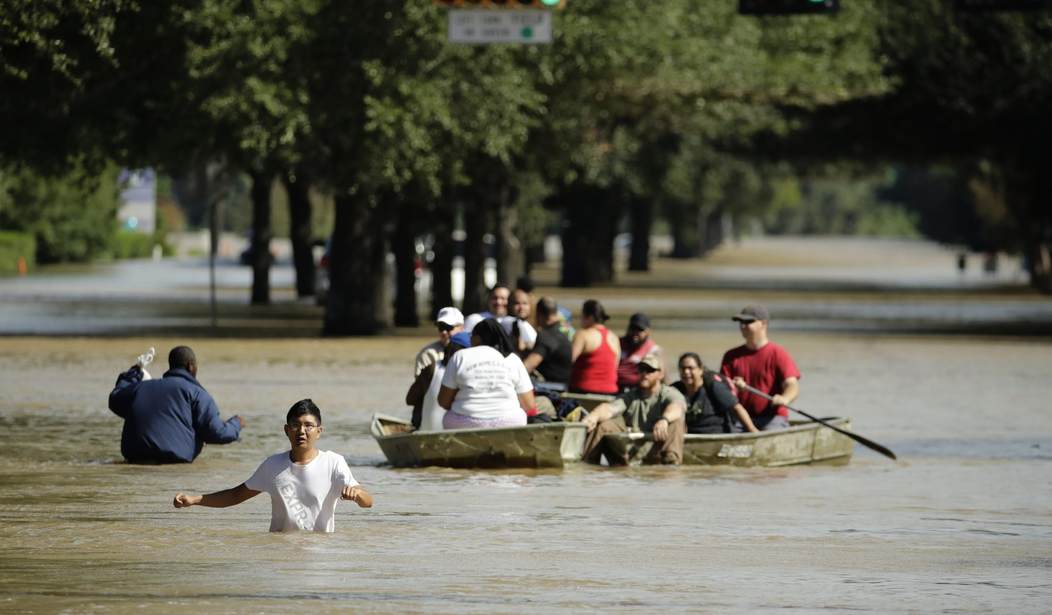This article was originally published in September 2017.
When it comes to natural disasters, probably everyone is thinking of Hurricane Harvey and its destruction in and around Houston. In addition to that devastation, there are also wildfires raging in southern California and Montana (hundreds of people have had to evacuate). Aside from those terrible disasters, most people don’t spend much time thinking about chemical spills, blizzards, tornados, riots, or terrorist attacks.
Now that I have your attention, are you taking steps to protect yourself and family in the wake of a disaster?
In some cases (as with hurricanes), we can be notified days in advance and respond accordingly. (Having actually lived through a hurricane once before, I strongly urge people to evacuate well before one hits.) In other instances (tornado touching down), there is very little warning. With a terrorist attack, there is no warning.
In a disaster you may face loss of electricity and water for just days, or it may be something catastrophic (like Hurricane Katrina or Harvey) and there will tremendous loss of emergency services and possibly even loss of life. Are you doing what you can to prepare for such disasters?
While we cannot prepare for every single possible situation, we can plan and gather supplies NOW while there is time in order to lessen our suffering in the future. Here are a few things to consider, some supplies to gather, and plans to make.
1. Know the rule of three.
Do you have supplies on hand in your home or car to survive for three days? If you had to shelter in place in your home, and there was no electricity and the water was cut off (or contaminated), would you have enough right now to take care of yourself and your family for the next three days?
Most people would laugh and tell me, “Of course I would! We have plenty of food in the fridge and pantry.” Great. But how about clean drinking water? Remember, the water is now contaminated and you have no electricity. So you can’t boil water on your electric stove. What will you do? (Hint: You can drain the water out of your hot water tank, but you still probably want to boil it. Do you have a way to purify the water without using electricity?)
If you are away from home, do you have supplies in your office or car that can keep you going for the next three days, or until help arrives? You need to think about that now … not when the disaster strikes.
Once you get that issue settled, then ask if you have enough supplies to survive for three weeks. Then think about what it would take to survive for three months.
Don’t laugh. When my parents and I rode out Hurricane David in September of 1979, we were without electricity for almost two weeks. It sure gets mighty hot in Georgia when there is no electricity and no air conditioning. All the food in our refrigerator and freezers spoiled. We were uncomfortable, but not dying. Other areas of town had electricity before ours was restored, so we could go to grocery stores and buy things to eat and drink.
But imagine if your town is like Houston right now, or like New Orleans in 2005. What would you do? As for surviving three months without any electricity or running water, it is a very real possibility if a nation like North Korea or Iran fired a nuclear missile to explode hundreds of miles up in the atmosphere, thus causing an electromagnetic pulse that would wipe out the power grids in parts of our country. Millions without power, for a long time. It is certainly something to think about.
2. Get your bags and totes ready.
I’m not talking about shopping bags. I’m talking about a “Bug-Out-Bag” (affectionately known as “BOB”). Some people refer to these as “Go Bags” or “Get Home Bags.” You should have one prepared for each member of your family. It’s also not a bad idea to have one in each car. Yes, I know that some people will think I am a paranoid weirdo … I’m used to it. If the manure hits the fan, however, I will be prepared.
You can buy these bags already made for you. This one for sale on Amazon contains many of the items you would need for more than three days. Personally, I like to save my money and make my own bags.
Each bag I have made contains freeze-dried food and energy bars, water purification tablets, a flashlight, emergency medical kit, toilet paper, cordage (550 cord), several tools to make a fire (a small jar of petroleum jelly and some cotton balls are great for making a long-lasting fire), waterproof matches, compass, pen and pencil, soap, razor, writing tablet, small handsaw, change of clothing, and a tool kit. That’s just for starters; you put in there whatever you think you will need to survive for days.
I also urge families to prepare a larger “emergency tote” that you can throw in the back of your car if you have to make a quick “getaway.” (Imagine a chemical spill somewhere or a wildfire and you have maybe fifteen to twenty minutes to get in the car and scram.)
Put extra food, bottled water, toilet paper, diapers (if you have babies and toddlers), medicine, and a Katadyn water filtration system in the tote. The filtration system we have can purify 200 gallons of water. I’ve actually used it; I purified scummy pond water instantly and drank pure clean water in seconds with zero side effects.
3. Other things to keep in the car.
It also may be a good idea to have sleeping bags and an all-weather tent prepared and ready to throw in the car at a moment’s notice in case of evacuation. Next to the sleeping bags and tent, have a camping toilet. They are worth their weight in gold. Your car should always have a car charger for cell phones, and in the back a set of jumper cables, a tarp, a fire extinguisher, a flashlight (I can’t have too many of those), and a warm blanket.
Where I live, it gets pretty cold in the winter. Blizzards are a real possibility, so if you are stuck in your car for days, having a warm blanket or two and some emergency winter clothing packed in the car is a smart idea. Some people also stash some flares, a small collapsible shovel (to dig your way out if your car is stuck in snow … I’ve actually had to do this on more than one occasion) and packages of “hand warmers.” These little packages are great to keep your hands and feet warm when the weather is arctic.
4. What about pets?
It was heart-wrenching and also heart-warming to see so many people rescue the dogs and cats in the wake of Hurricane Harvey. There is no way I’m going to leave my poor animals if I have to evacuate. I’m sure you are the same. So, do you have extra pet food? Whether you are staying or leaving, do you have, right now, enough pet food for three days, three weeks, or even three months? Now is the time to make sure you have enough.
Make sure you have a cage big enough to transport your furry friend. Remember the scenes of the rescue workers who brought out all the dogs and cats in cages? Imagine if the pet owners did not have something like that (especially for the cats … those poor creatures would have panicked and torn up the rescuers if they were not in cages).
This video will break your heart, and warm it at the same time:
Think of your little fur babies when preparing for a disaster.
5. Plan, drill, train.
As soon as I say that, I know lots of people will start rolling their eyes. I know I sound like a fearmonger. However, do your kids do fire drills at school? Why? Because we all know there could be a fire. Do you do tornado drills or active shooter drills at work? Many do. If you don’t, you should. Why? Because we all know these things are very real and very possible.
So why don’t we do drills at home to prepare for a disaster? It doesn’t have to be anything terribly elaborate.
First, write down on a list everything you would take with you if you had to evacuate your home. Where are all your most important papers (title to your house, your car, passports, birth certificates, other critical banking info)? Are they in a fireproof safe? Good. Know where it is and be prepared to grab it and go.
Do you have cash on hand? It is a very good idea to have a stash of cash that is reserved only for disaster emergency. Make sure you take that with you (nothing communicates like cash). Where is your emergency tote? Emergency medical kit complete with all your prescription medication? If you are taking any firearms with you, make sure you know all the rules of gun safety cold, and have the firearms and ammo ready to go.
Do the kids know what to do? If they are at school, do you have a plan to communicate with them and get them? Is there a rendezvous point if people are separated? Do you know under what conditions you would either shelter in place at home, or evacuate? If you must evacuate, where will you go, what routes will you take, and how long will it take? It is a good idea to start answering these questions now.
Next, drill. A Marine once told me, “you will not rise to the occasion; you will fall back on your training.” So train. You will fight like you train, and you will respond to disaster like you train. Make it a competition! Can you get everything you plan on taking into the car and ready to pull out of the driveway in fifteen minutes? Ten?
Does everyone know how to build a fire, clean and dress a wound, jumpstart a car, or set up a tent? Now is a good time to start learning these skills. YouTube and good books are wonderful tools to have to learn these skills now. To learn first aid, I recommend either going to the Red Cross, learning from an expert in emergency medicine. Don’t wait until the emergency is in front of you and there is no one to help.
This article is only an introduction. I know full well that I did not address every single issue. Believe it or not, I do not obsess on “prepping;” I live a normal life and go about my business without thinking about terrorist attacks or hurricanes. I have been accumulating information and taking steps to prepare my family over many years now.
However, I hope that by asking good questions, and suggesting some solutions, I have spurred an interest in some who otherwise might not think about a disaster … until it is too late.









Join the conversation as a VIP Member